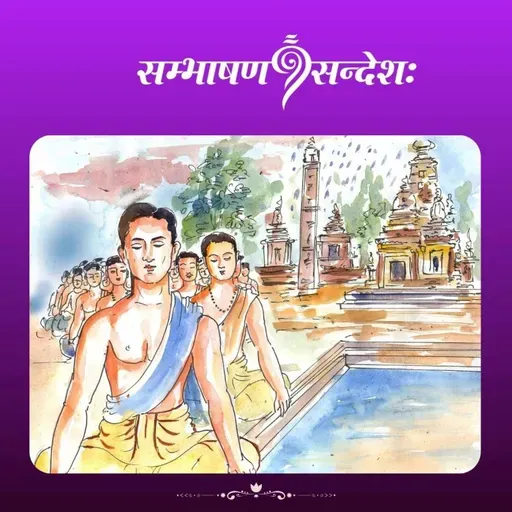
अष्टादशवर्षपूर्वं स्यानन्दपुरे पद्मतीर्थनामा तडागः निर्जलः जातः । कथञ्चित् अयं तडागः जलपूर्णः स्यात् इति जनाः अचिन्तयन् । तदा तस्य कार्यार्थं डा. साम्बशिवनामकः कश्चन सज्जनः जनान् प्रेरितवान् । साम्बशिवस्य न केवलं वैद्यकीये विषये, अपि तु वेदोपनिषत्सु अपि अध्ययनम् आसीत् । अग्रिमदिने सर्वे ब्राह्मे मुहूर्ते अनशनपूर्वकान् आर्द्रवस्त्रान् जनान् वरुणमन्त्रं बोधितवान् । ऋग्वेदस्य वरुणमन्त्रः श्रद्धया एकोत्तरशतवारम् उच्चारितः । तस्यां रात्रौ महती वृष्टिः जाता, प्रातः पद्मतीर्थं जलपूर्णम् अभवत् । मन्त्रशक्तिः, जनानां निःस्वार्थता, अनशनं च वृष्टेः हेतुः अभवत् । अहम्भावं त्यक्त्वा जनैः लोकहिताय कृतस्य कार्यस्य फलम् इदम् ।
(“केन्द्रीयसंस्कृतविश्वविद्यालयस्य अष्टादशीयोजनान्तर्गततया एतासां कथानां ध्वनिप्रक्षेपणं क्रियते”)
Eighteen years ago, the Padmatīrtha lake in Syanandapura had completely dried up. The locals wondered how it could ever be filled again. At that time, a noble man named Dr. Sambashiva took the initiative to inspire the people. He was not only a medical expert but also well-versed in the Vedas and Upanishads. The next morning, at the sacred hour (brāhma muhūrta), he gathered people dressed in wet clothes, fasting, and taught them the Varuṇa mantra. With deep faith, the mantra from the Ṛgveda was chanted 101 times. That very night, heavy rain fell, and by morning, the Padmatīrtha lake was full of water. This event showed that the power of mantras, the people’s selflessness, and their fasting led to the rainfall. It was the fruit of a collective act done for the welfare of all, free from ego.